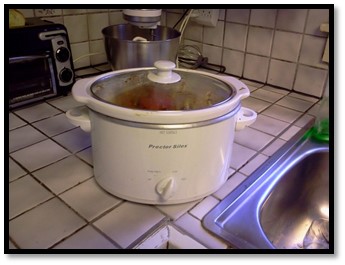 I like to do Freezer Cooking, OAMC (Once a Month Cooking), whatever you want to call it. I like to cook. But the reality is that there are nights where I blasted well don’t feel like cooking. Maybe I’ve been on my feet teaching all day. Maybe I’ve dived into my writing to the point where I look up and realize it’s getting on to dinner time and I don’t want to take the time out to make a meal that night. Maybe the family’s just plain busy and it’s not realistic to dump the cooking duties on someone else. So, I like to have a few meals in the freezer for those times.
I like to do Freezer Cooking, OAMC (Once a Month Cooking), whatever you want to call it. I like to cook. But the reality is that there are nights where I blasted well don’t feel like cooking. Maybe I’ve been on my feet teaching all day. Maybe I’ve dived into my writing to the point where I look up and realize it’s getting on to dinner time and I don’t want to take the time out to make a meal that night. Maybe the family’s just plain busy and it’s not realistic to dump the cooking duties on someone else. So, I like to have a few meals in the freezer for those times.
If you do a search for some variant on the keywords “Crockpot Freezer Cooking” you’ll find a new method for making meals for the freezer that has taken me two days to fall in love with.
What you need: A slow cooker, some recipes you like, some gallon freezer bags, and a freezer. (And you have to like crock pot meals. If you don’t, stop reading now. This isn’t for you).
This is a psycho easy way to have meals prepped to pop in the crock pot of a morning. My family and I prepared about a month’s worth of dinners this way and it took us an hour and a half from start to cleanup. If you don’t have a sous-chef you might want to tack on another half an hour to 45 minutes, but that’s about it. Still, you’re looking at under three hours of prep time for a month’s worth of dinners. This is nothing like the all-day cooking sessions for classic OAMC.
When you do classic OAMC, you cook meals in advance, thaw them and then heat them up on the day you want to serve them.
With Slow Cooker Freezer Cooking, you only do the prep work and store the uncooked meals in the freezer to thaw and toss in the crock pot the morning before you want to serve it. Just prep everything like you would to pop it in the crock pot, but put it in a freezer bag instead, and freeze it flat. Yes, it’s that easy.
One thing with this cooking method, you’re gonna wanna label everything, and add any special instructions. I don’t freeze most of these meals with a lot of additional liquid. So if you need to add stock, or coconut milk or something like that when you cook it, write those instructions on the bag. Don’t count on remembering it.
If you’re a crock pot aficionado, you probably already have dozens of recipes. Don’t sweat it, they’ll work using this method. I do recommend browning the hamburger so you can drain the fat for any meal using ground beef, but other than that, no real cooking in advance is necessary.
If you need some recipes, these are some that I used for my last session. They fit in a three quart slow cooker, and will usually provide a couple of meals for my three-person family. (Why yes, I do freeze leftovers for another meal!) If you’re using a six quart crock pot due to a larger family, you’ll want to double these recipes, but they won’t fit in a single gallon freezer bag.
White Chili
½ lb. Dry white beans, cooked (or two 15 oz cans)
1 lb. chicken breast, diced
½ c. chopped onion
2 T chopped garlic
1 T oreganof
1 T Cumin
2t. black pepper
1 can chopped green chili peppers
Put all the ingredients in a gallon freezer bag. Freeze.
Defrost in the fridge for 12-18 hours, put in crock pot, add ~1 quart chicken stock. Cook 6-8 hours on low, serve with salad.
Chicken Curry
1 lb chicken breasts, cut into small pieces
3c. potatoes, diced
1 c. plain yogurt
1/4 c. raisins, ground
1/4 c. cashews, ground
1 c. peaches, mango, or apricots, diced
½ c. onion, diced
3T garlic, chopped
3T fresh ginger, chopped
4 T curry powder
Put all the ingredients in a gallon freezer bag. Freeze.
Defrost in the fridge for 12-18 hours, put in crock pot, add 15 oz can coconut milk. Cook 6-8 hours on low, serve over rice.

 So, here I am on a disused train trestle bridge having my hand held like a daggone three year old while my heart is trying to pound through my chest and I can’t stop myself from looking down through the gaps in the trestle to the Certain Death below.
So, here I am on a disused train trestle bridge having my hand held like a daggone three year old while my heart is trying to pound through my chest and I can’t stop myself from looking down through the gaps in the trestle to the Certain Death below. Enthusiasm for safe and pleasant walking or biking, as well we recreation areas, can be seen even among the improvements put in by locals. At the beginning of the Greenway, just outside of the tunnel under Hanover Street, a young man chose to create a “pocket park” as an Eagle Scout project. As you can see, it looks wonderful and is a great place to hang out and enjoy a little piece of the Mascoma River.
Enthusiasm for safe and pleasant walking or biking, as well we recreation areas, can be seen even among the improvements put in by locals. At the beginning of the Greenway, just outside of the tunnel under Hanover Street, a young man chose to create a “pocket park” as an Eagle Scout project. As you can see, it looks wonderful and is a great place to hang out and enjoy a little piece of the Mascoma River. project, as she’d like to see it completed!
project, as she’d like to see it completed!

